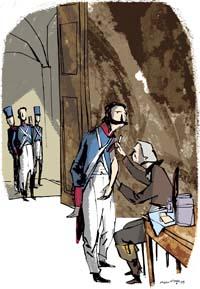The conquest Baztango

In the fields of Kingscote (Gloucestershire, England), on September 2, 1784, those who saw the balloon come down from heaven would not immediately forget that image. "The followers were so scared, it took them a lot to approach," Gloucester Journal said. It is not surprising that at that time the aerostatic balloons were very well known. The first, dismissed in France two years earlier, frightened the Segalaris to become one of the first in England. He left Berkeley, about 16 kilometers from the hand of Edward Jenner.
Jenner was not an expert on these issues. But he had great powers to experiment and investigate, and at that time the first tests were being done with balloons, he could not even stay without making his own test. Jenner was going to do much more than take off balloons, but, even in the personal field, this experiment had its importance. The hydrogen balloon ended its flight on Anthony Kingscote's land. And there Jener met one of the three daughters of Kingscot, Catherine. 4 years later they married.
Jenner was a doctor on his own. He learned with a surgeon at age 14 and at age 21 John Hunter traveled to London to train with the most prestigious surgeon of the time. He soon became a student of Hunter's eyes and a lifelong friend.
In addition to the profession, the fans gathered the two friends. Jenner became fond of everything related to nature from a young age, and especially to animals. Hunter and both of them were very curious to know how some plants and animals could stop their lives during the winter. Thus, Jenner, driven by Hunter, investigated the bodily temperatures of the hedgehogs. And in the stomach of the hibernating hedgehogs also put food to see if they would digest.
Jenner also investigated bird migrations. And for the first time, observe the behavior of newborn spots. The cuckoo puts its egg in the nests of birds of another species. The host's own eggs disappear and culminate with the mother cuckoo. Jenner discovered that the newborn cuckoo was the one that pushed the other eggs or chickens downstream of the nest, and to do so he discovered that the cuckoo riders had a depression in the back that helped them manage the eggs and disappeared in 12 days.
During his stay in London, Cook also offered him a post as a naturalist in the captain's second expedition. But fortunately he decided to return to Berkeley to devote himself to medicine.
At that time, smallpox was causing numerous deaths across Europe. The only way to deal with the disease was that Lady Mary Wortley Montague saw in Turkey and brought her to England: inject the pus of those who had a weaker corner. The survivors did not catch more smallpox. But that didn't always happen.
Jenner was also given this treatment as a child. He suffered a lot and never forgot that experience. She also used this technique to protect her patients from the shore. But we had been thinking about something else for some time. He had heard that those who caught the smallpox of cow contaminated by cows never hunted. And Jenner ignored the rumor that was on the street.
Bovine is a variant of the common arcen that affects the udders of the cows. The women who milked the cows, sometimes infected with the cows' hut, causing a few days of discomfort and grains, but nothing serious. And these women were immunized with respect to the common baztanga.
In May 1796, Sarah Nelmes went to Jenner concerned about a law that left her in her arms. The doctor believes it was not a corner, diagnosed that of the cow. Sarah corroborated the diagnosis: her cow Blossom had just had a bovine smallpox. It was the opportunity of Jenner. I had to put the smallpox of cow to someone who had not yet had smallpox.
James Phipps, eight-year-old son of his gardener. He injured him in the child's arm and put in the material extracted from Sarah's law. After a few days he became ill: he had a cow smallpox. Now the last test was missing. The child was introduced to the Common Baztanga virus and, as expected, did not get sick. Neither at that time nor in all the following.
After Phipss, try with other children. And also with his 5-year-old son. In 1798 he published a paper that showed that smallpox of cows served to protect themselves from the common area. It was the first scientific work on a vaccine. And, therefore, Edward Jenner is considered today the father of immunology. Since then the vaccine has been called a vaccine in English and a vaccine in Spanish (from the Latin vacca).
But the success of the technique did not come soon. The introduction in the body of the material from the cows caused fear that the vaccines could be "observed" in some way. Soon the drawings of the men with cow head appeared. And from the religious point of view it was also a problem the introduction in the blood of substances of beings inferior to the human being.
However, Jenner advanced and began distributing his material around the world. The rival, on the contrary, was expanding the use of the technique and, finally, Jenner achieved maximum recognition and reputation. Napoleon also ordered to insert his troops. And when Jenner wrote to him asking him to release some English prisoners he said: "Ah, Jenner, I can't deny you anything."
In 1801, writing about the dissemination of the vaccine, he finished: "...the final result of these actions must be the total elimination of baztanga, the most terrible penalty against man." It took 180 years to fulfill Jenner's prediction, but smallpox has been the first disease to be completely eliminated. In 1980 the World Health Organization formally declared: "Smallpox has died!"





